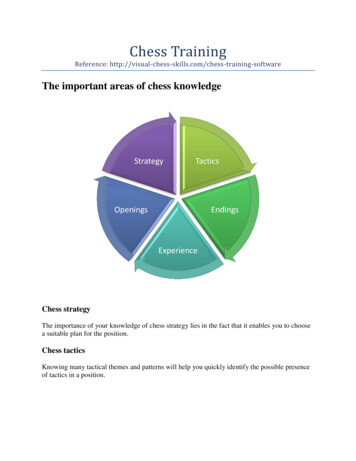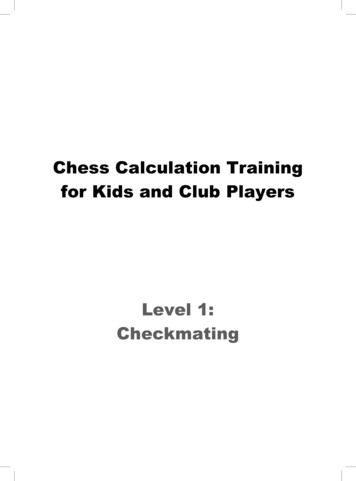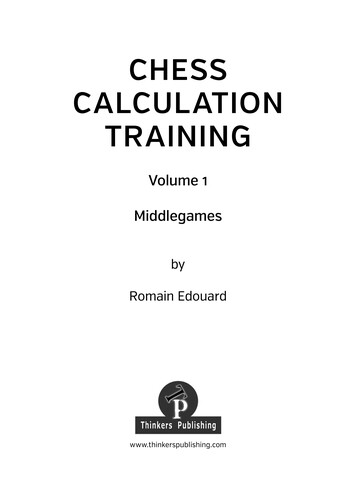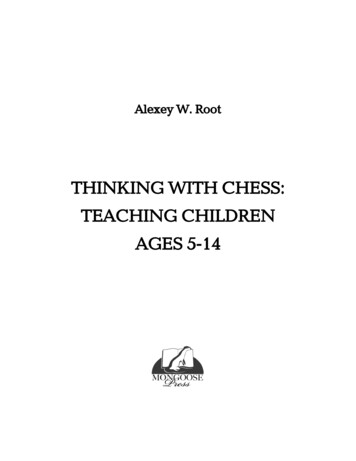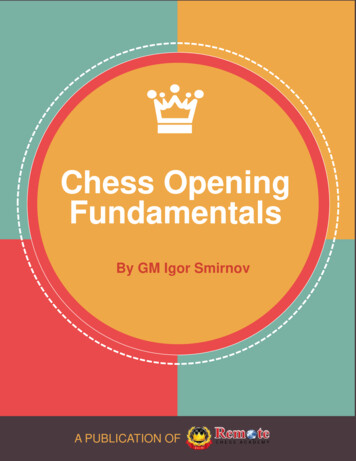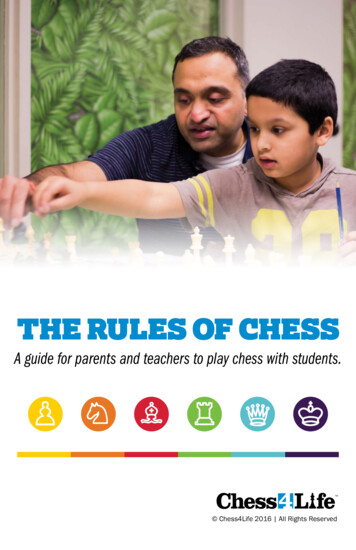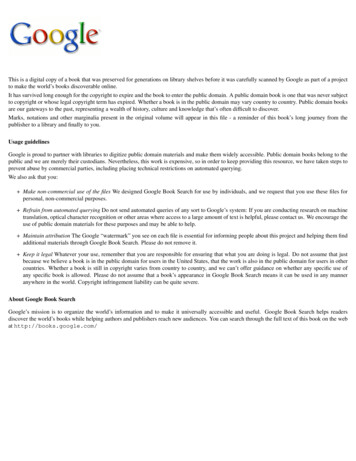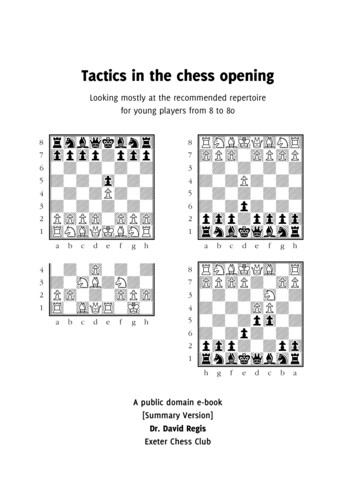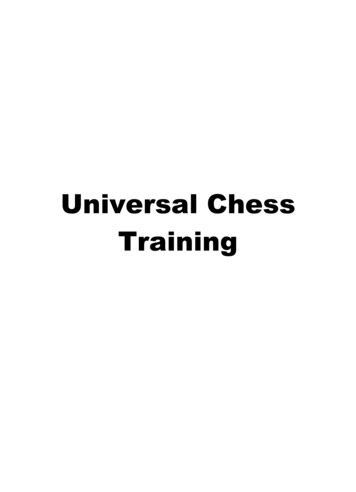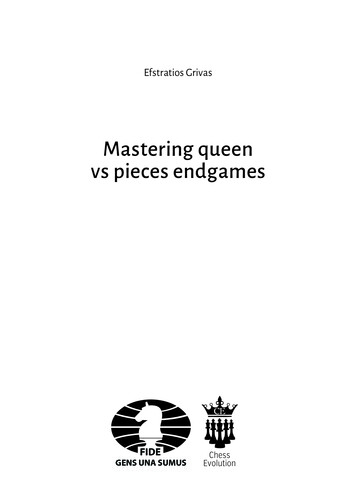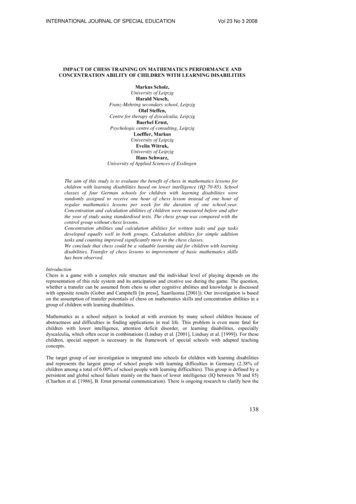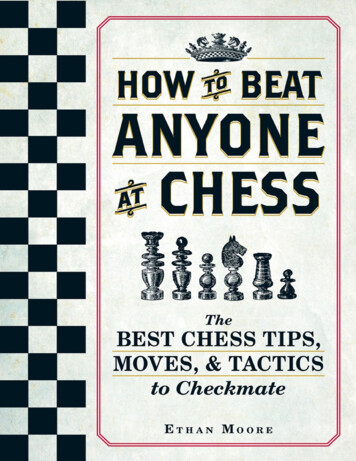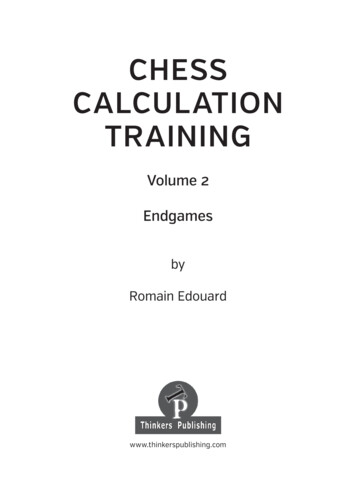
Transcription
CHESSCALCULATIONTRAININGVolume 2EndgamesbyRomain Edouardwww.thinkerspublishing.com
Managing EditorRomain EdouardAssistant EditorDaniël VanheirzeeleSoftwareHub van de LaarProofreadingAdam Emerson, Roger EmersonGraphic ArtistPhilippe TonnardCover designIwan KerkhofBack cover photoAna MatnadzeTypesettingi-Press ‹www.i-press.pl›First edition 2017 by Thinkers PublishingChess calculation training. Volume 2: EndgamesCopyright 2017 Romain EdouardAll rights reserved. No part of this publication may be reproduced, stored in a retrievalsystem or transmitted in any form or by any means, electronic, mechanical, photocopying, recording or otherwise, without the prior written permission from the publisher.ISBN 978-94-9251-015-0D/2017/13730/10All sales or enquiries should be directed to Thinkers Publishing, 9000 Gent, Belgium.e-mail: info@thinkerspublishing.comwebsite: www.thinkerspublishing.com
TABLE OF CONTENTSKEY TO SYMBOLS5PREFACE7CHAPTER 1: WARM UPSOLUTIONS – CHAPTER 1239CHAPTER 2: TEST YOUR REFLEXES!SOLUTIONS – CHAPTER 22949CHAPTER 3: FIND THE TECHNICAL WIN!SOLUTIONS – CHAPTER 36981CHAPTER 4: UNEXPECTED BLOWS!SOLUTIONS – CHAPTER 4109CHAPTER 5: FIND THE DRAW!SOLUTIONS – CHAPTER 5133CHAPTER 6: MAKE THE RIGHT CHOICE!SOLUTIONS – CHAPTER 6151161CHAPTER 7: IN SECONDS!SOLUTIONS – CHAPTER 7179CHAPTER 8: FIND THE MISSED MOVE!SOLUTIONS – CHAPTER 8185193CHAPTER 9: EVALUATE THE POSITION!SOLUTIONS – CHAPTER 9207CHAPTER 10: A SIXTH SENSE FOR ENDGAMES?SOLUTIONS – CHAPTER 10229CHAPTER 11: SPECIAL SECTIONSOLUTIONS – CHAPTER 11245257HELP SECTION97119171199219271
KEY TO SYMBOLS!a good move?a weak move!!an excellent move?a blunder!?an interesing move?!a dubious move only move equality unclear position with compensation for the sacrificed material White stands slightly better Black stands slightly better White has a serious advantage Black has a serious advantage White has a decisive advantage Black has a decisive advantage with an attack with initiative with counterplay with the idea of better is worse isNnovelty check#mate(T)theoretical position(*)hard puzzle
PREFACEWelcome to the 2nd volume of my “Chess Calculation Training” series!This book focuses on endgames. There are a lot of things to learn “by heart”about them — but they are often difficult to apply at the board, unless youget exactly the same position as you studied. This is why I believe it is an interesting approach to present an endgames book as a series of exercises,with instructive but practical positions.As in Volume 1, a lot of calculation will be required. The major difference between middlegame and endgame training is, of course, the limited materialon the board. This means the patterns you discover in training are muchmore likely to appear in your games — so you should try to imprint themsomewhere in your memory!With ordinary tactics, the purpose of exercises is almost solely to improveyour calculation skills. Solving the exercises of this book will help the readerimprove on his endgame knowledge and understanding as well. There isa lot to learn from studying each solution, even if you failed to find it yourself; this is why answers here are even more detailed than in Volume One.Nevertheless, the solutions are always concrete.This book contains 10 chapters. The first, as in Volume 1, is a warm-up. Thenwe will work on endings from all possible angles: technical wins, tacticalwins, drawing moves, and so on. Another very important chapter is “Testyour reflexes!”. I believe reflexes are a key element in becoming a good endgame player. The more good reflexes you develop, the more other thingsbecome reflexes too!To prepare this book, I looked at a huge number of games and pre-selectedaround 800 positions. By analyzing them more deeply than I would normallydo just watching a game online, I discovered an incredible number of newideas. These I pass on to you!Throughout the book, the most challenging exercises are marked with a (*).The theoretical positions, which it is essential to memorise, are marked with
a (T). You will find a help section at the end of the book, giving guidance(if needed) for any exercise marked with an asterisk.I hope this book will be an excellent complement to the pure knowledge youmay gain from other more general endgame books!Romain EdouardSeptember 2017
Chapter 1Warm upAs the title indicates, this part of the book is a training exercise.In each position you must find the winning move, or the drawing move ifyou see an equals sign ( ) underneath the diagram. If there seems to bemore than one solution, choose the clearest or the quickest.This chapter contains exercises of all types, which could have been usedin several other chapters. They appear here because they are easier tosolve and will help to prepare you for the rest of the book!I advise you to solve a few problems (a page, for example) as a warm-upbefore attempting a more complicated chapter. Beware: a few positionsare more challenging than the others.
10 1 2Bukic, E. – Marovic, D.Tal, M. – Averkin, O. 59.? – 70.? – 3 4Salov, V. – Seirawan, Y.Topalov, V. – Leko, P. 35.? – 25.? CHESS CALCULATION TRAINING. VOLUME 2: ENDGAMES
Chapter 2Test yourreflexes!Welcome to one of my favourite chapters! To become a great endgameplayer, you must be knowledgeable, objective and good at calculation.This chapter is about the fourth critical element: reflexes.The term ‘reflexes’ covers everything that you should be able to do withvery little thought. They will help you in situations where you have a limited amount of time: which is to say always!In this chapter, you must let your instinct guide you to the solution. Theautomatic defence, the natural pieces placement, avoiding the only trap,the obvious exchange, typical winning shots, keeping the opponent’spieces in the box, will be the covered topics. Try to find the right moveafter a short reflection, then give yourself more time to question yourdecision.The problems marked with an asterisk (*) are more difficult: they requiresome calculation as well as good ‘reflexes’. You will find hints in the helpsection at the end of the book. This chapter also contains some theoretical positions you should learn. You will find them marked with a (T).
30 1 (T) 2 (T)Fischer, R. – Sherwin, J.Gligoric, S. – Fischer, R. 78.? 74.? 3 4Korchnoi, V. – Karpov, A.Kasparov, G. – Vukic, M. 80.? 36.? –CHESS CALCULATION TRAINING. VOLUME 2: ENDGAMES
Chapter 3Find thetechnical win!In this chapter, you must find the winning move or variation. The solutions need some calculation of course, but they are more technical innature.The positions considered to be theoretical which you should learn aremarked with a (T).The difficulty of the exercises in this chapter ranges from medium tovery difficult. The most challenging exercises are marked with an asterisk (*), which means you will find hints in the help section at the end ofthe book.
70 1 2Garcia, S. – Karpov, A.Ljubojevic, L. – Karpov, A. 67.? – 46.? – 3 4 (*)Hracek, Z. – Sokolov, I.Tondivar, B. – Lutz, C. 48.? – 45.? – CHESS CALCULATION TRAINING. VOLUME 2: ENDGAMES
Chapter 5Find the draw!In this chapter, you must find the move or the varia on which leads to a draw.You will o en be surprised by how many resources are hidden in an endgamewhich looks hopeless.This sec on is a mixture of theore cal posi ons (T) and instruc ve endgamesof all types. It should help you learn a great deal about defensive methods andthemes in difficult endgames.In this chapter, even more than in the others, seeing the first move is not enough:your calcula on must lead you to a posi on which is unques onably a draw.The difficulty of the exercises in this chapter ranges from medium to very difficult. The most challenging ones are marked with an asterisk (*), which meansyou will find hints in the help sec on at the end of the book.
120 1 (*) 2Sakharov, Y. – Vasiukov, E.Karasev, V. – Karpov, A. 61.? 72.? 3 4 (*)Sokolov, I. – Damljanovic, B.Tamm, U. – Kramnik, V. 68.? 68.? CHESS CALCULATION TRAINING. VOLUME 2: ENDGAMES
Chapter 6Makethe rightchoice!In this chapter, for each exercise I will suggest two possible moves. Oneof them is a mistake! You must work out which one is correct and, aboveall, the reason why the other is an error.Pure calculation is needed. In general, at least one of the two moves —sometimes both – hides an unexpected possibility, which makes theseproblems even more interesting!This chapter is intended to help you to work on your ability to calculate, while also developing your sense of danger when you have to rejecta move which seems good at first glance.The difficulty of the exercises in this chapter ranges from medium tovery difficult. The most challenging ones are marked with an asterisk(*), which means you will find hints in the help section at the end of thebook.
152 1 2 (*)Ivkov, B. – Webb, S.Van Wely, L. – Kramnik, V. 54.h5 / 54.g5 55. f2 / 55. f4 3 4Van Wely, L. – Cvitan, O.Sokolov, I. – Salov, V. 54. d4 / 54. d5 73. xd1 / 73. a5 CHESS CALCULATION TRAINING. VOLUME 2: ENDGAMES
Chapter 7In seconds!This chapter is a follow-up to chapter 2 and will also be great training foryour reflexes!This chapter puts you in time trouble. In each position, you must playa move within 10, 20 or 30 seconds, depending on the exercise.You are given a short instruction and, in a few cases, you are givena choice between two moves (just like in the previous section). You mustfind the win or the only move to stay in the game, or avoid a trap.The problems themselves are not difficult, but the time limit makes thema real challenge!
1 2Bernstein, O. – Smyslov, V.Csanadi, L. – Forintos, G. 60.?You have 10 seconds left ,play a move! 52.?You have 20 seconds left:play a move! 3 4Seirawan, Y. – Illescas Cordoba, M.Kun, S. – Merenyi, G. 28.?You have 30 seconds left: find theonly move to stay in the game! 53.?You have 10 seconds left :play a move!172CHESS CALCULATION TRAINING. VOLUME 2: ENDGAMES
Welcome to the 2nd volume of my “Chess Calculation Training” series! This book focuses on endgames. There are a lot of things to learn “by heart” about them — but they are oft en diffi cult to apply at the board, unless you get exactly the same position as you studied. This is why I believe it is an in- teresting approach to present an endgames book as a series of exercises, with .
